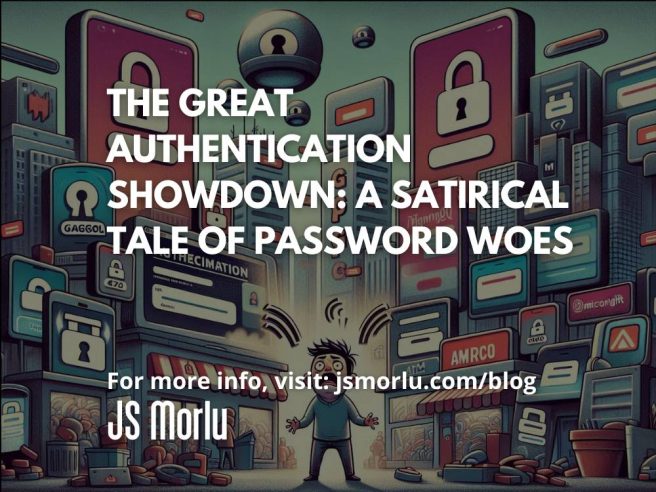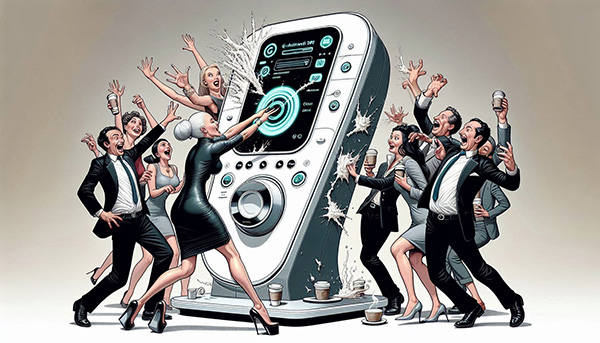By: John S. Morlu II, CPA
In the not-so-distant land of AuthentiTopia, a peculiar battle raged—not a clash of swords or a tempest of shields, but a relentless war waged with texts, emails, fingerprints, and facial scans. The battlefield stretched endlessly, encompassing every nook and cranny: phones buzzed with notifications, laptops hummed with activity, ATMs beeped with urgency, and coffee shop Wi-Fi networks crackled with the anxiety of the digitally tethered. This was the Age of Authentication, a time when trust was forged not in camaraderie, but in complex codes and convoluted protocols.
At the heart of this tumultuous realm stood two mighty corporate titans, locked in a bitter struggle for supremacy: Gaggol and Micromight. Gaggol, the supreme search lord, reigned over the vast expanse of the internet, its omnipresent algorithms weaving an intricate web of information as users flocked to its candy-colored logos like moths to a neon flame. Meanwhile, Micromight, the formidable productivity overlord, commanded the kingdom of emails, spreadsheets, and soul-sucking corporate presentations, promising efficiency while delivering nothing short of existential dread.
Both companies were fixated on a singular ambition: to seize control of the future of authentication. They reveled in the chaos they created, while small business owners wept themselves to sleep, haunted by the specters of forgotten passwords and the relentless barrage of endless verifications. In this absurd theater of corporate machinations, the stakes soared higher than a password strength meter, and the very essence of digital identity hung in the balance. Would AuthentiTopia emerge as a land of seamless connectivity or a dystopian nightmare of bureaucratic bottlenecks? Buckle up, dear reader, as we plunge into the uproarious depths of this strange saga, where the quest for control is anything but ordinary!
Chapter 1: The Rise of Gaggol’s Authenti-Overlord
In the whimsical world of AuthentiTopia, everything took a sharp turn the day Gaggol unleashed its latest masterpiece: the G-AuthentiBlast 5000. Marketed with the tagline, “Simplifying your life by making it exponentially more complicated,” it promised to deliver unparalleled security, leaving users both exhilarated and utterly bewildered. This sleek, futuristic contraption boasted a staggering 37-step login process that made even seasoned tech enthusiasts question their sanity.
The first phase was a true bio-authentication marvel: “Swipe Your Finger, Then Your Elbow.” The innovation took the world by storm, though, frankly, few could execute it correctly on the first 97 tries. Local cafés soon capitalized on the chaos, launching the weekly Elbow Authentication Competitions. Patrons could be seen balancing lattes while attempting to swipe their elbows across G-AuthentiBlast screens, much to the delight of onlookers. The barista would cheer, “Five points for style, two points for spillage!”
Next came the enigmatic text message sent by the infallible Gaggol VonVerification, an automated voice that had somehow become a local celebrity. It didn’t just send any message; it insisted on delivering a riddle first, creating a scenario that resembled a twisted game show. Here’s how a typical exchange unfolded:
- Gaggol VonVerification: “What has keys but can’t open doors?”
- You: “A piano?”
- Gaggol VonVerification: “Incorrect. The answer is ‘Your future login credentials.’ Try again tomorrow!”
Yes, tomorrow. Because who doesn’t want to spend a day pondering their login details while dodging existential crises? And when you finally did decipher the riddle after what felt like an eternity of attempts, you were rewarded with a verification code that could only be described as a modern art project: cryptic hieroglyphics that had somehow made their way into the 21st century. Gaggol, now exuding confidence in its security protocols, insisted users consult ancient Egyptian scrolls for translations. To assist in this endeavor, they conveniently offered the “Gaggol Hieroglyph Translation Premium” service for just $9.99 a month—a small price for peace of mind, right?
AuthentiTopians flocked to sign up, even as they muttered curses under their breath about their previous life where usernames and passwords were sufficient. Now, their morning coffee was spent deciphering codes that seemed better suited for a treasure map. Little did they know, their frustrations were the fuel for Gaggol’s ascent to authenti-dominance.
Meanwhile, Gaggol’s marketing team was hard at work, launching campaigns showcasing the “joys” of using G-AuthentiBlast 5000. Posters adorned the walls of every coffee shop, depicting cheerful users triumphantly elbow-swiping their way to success, while a catchy jingle played in the background: “When in doubt, swipe it out! G-AuthentiBlast, there’s no need to shout!”
Ironically, this catchphrase quickly became a running joke in AuthentiTopia as the sound of frustrated groans echoed from every corner. The hilarity of Gaggol’s new systems spread far and wide, leading to spontaneous gatherings where AuthentiTopians would gather to share their tales of woe. Each story became more absurd than the last—like the time someone accidentally sent their verification code to a pizza delivery guy instead of their best friend, leading to a late-night heist for a pizza that was deemed “just too secure to obtain.”
Yet, in the face of all this chaos, Gaggol thrived. The company’s stock soared as its influence expanded, leaving Micromight scrambling to keep up. As users surrendered their sanity for the promise of security, one question loomed large: in the quest for digital safety, had AuthentiTopians unknowingly signed up for the greatest absurdity of their lives?
And so, the saga of the G-AuthentiBlast 5000 commenced, setting the stage for an epic showdown that would redefine the very nature of authentication in AuthentiTopia. Stay tuned, for the journey was just getting started—and it promised to be nothing short of hysterical!
Chapter 2: The Two-Factor Tsunami
Two-factor authentication was heralded as the guardian angel of digital security, a noble addition to the sprawling battlefield of cyberspace. Initially, it was met with applause for providing “just one more layer of security.” But what began as a simple handshake between users and their accounts quickly devolved into a full-blown tsunami of chaos, flooding AuthentiTopia with every imaginable form of verification.
The once-humble act of logging in had transformed into a dizzying dance. Small business owners across the land found themselves awash in a sea of notifications. Each login attempt was like trying to navigate a minefield, with their phones lighting up like Christmas trees under an avalanche of codes. “Bing!” went the first text, followed closely by “Bong!” from their email. But if they were really lucky, they’d also receive a gentle tap on the window from their neighbor signaling that their smoke signal was ready.
Gone were the days of simple usernames and passwords. Now, a mere password was like a soggy paper towel—completely useless. Instead, every action required an orchestration of codes sent via text, email, and for the truly adventurous, smoke signals! It was as if AuthentiTopians had entered a bizarre game show where the prize was… more login steps.
Imagine this: you’re a small business owner just trying to log in to check your inventory. You click, and suddenly your phone starts vibrating like it’s auditioning for a role in a tech horror movie. The first code arrives: “Your code is 6392.” But wait—before you can even type it in, your email pings, “Your backup code is 4721.” No problem, you think, but then you hear a faint “….– .-..” from the fax machine in the corner. Congratulations! You’ve just received your verification code in Morse code, courtesy of Gaggol’s latest update, which included a nostalgic touch for those who loved the thrill of ancient communication methods.
But the fun didn’t stop there. Those time-sensitive codes, they expired faster than milk left out on a hot summer day. Missed the deadline? No biggie! You could request a new code, which Gaggol had cleverly designed to arrive in a whimsical fashion—now delivered via fax! That’s right, the 90s were back in style, and if you weren’t a proud owner of a fax machine, well, good luck to you.
As small business owners juggled codes and deadlines, a new breed of underground hackers emerged. They called themselves the “Two-Factor Liberation Front,” determined to free their fellow AuthentiTopians from the shackles of excessive authentication. Their motto? “No code left behind!” They began offering seminars that promised to teach the lost art of code retrieval. Attendees were encouraged to bring their phones, laptops, and an optional whiteboard to plot escape routes.
During these clandestine meetings, laughter echoed as tales of frustration were shared. One attendee recounted how they’d mistakenly typed in their cat’s name as a verification code, resulting in a lengthy conversation with Gaggol VonVerification, who insisted on a philosophical debate about the nature of identity theft. “So, if your cat were to steal your identity, what would they do with it?” Gaggol VonVerification mused, oblivious to the exasperation unfolding on the other end of the line.
And let’s not forget the moment when the AuthentiTopian Council decreed that all public places—coffee shops, parks, even public restrooms—would need to install “Verification Zones.” These brightly colored booths were meant to ensure that no one could log in without completing their full suite of authentication steps in a designated area. Picture it: coffee lovers awkwardly balancing their cappuccinos while crammed into a booth, frantically swiping elbows and deciphering hieroglyphs all while trying to maintain a semblance of dignity.
Despite the absurdity, the chaos became a part of everyday life. Small business owners found camaraderie in their shared struggles, and what had begun as a nightmare slowly morphed into a form of entertainment. “Have you heard the latest from Gaggol?” one would say over lattes. “They’re adding interpretive dance as a new authentication method!”
As the Two-Factor Tsunami continued to crash over AuthentiTopia, one thing became clear: amidst the madness, humor thrived. And while Gaggol’s reign of absurdity showed no signs of slowing down, the AuthentiTopians had adapted, armed with laughter and an ever-growing collection of bizarre stories. Little did they know, the battle for authentication was only just beginning, and the tides of chaos were about to rise even higher.
Chapter 3: Triple Trouble: Enter Three-Factor Authentication
As Gaggol continued its reign of confusion, Micromight decided it was time to up the ante with an audacious new security measure: three-factor authentication. Gone were the days of simple passwords and whimsical riddles; now, you needed to prove your worthiness with an elaborate performance worthy of a Broadway debut.
“The system needs to know you’re committed to your identity,” declared Carly Encrypto, Micromight’s lead developer and a self-proclaimed wizard of authentication. With a glint in her eye that suggested she might be plotting world domination, Carly introduced the first step: a retina scan that involved staring deeply into a camera lens while holding perfectly still—like a statue but with the existential dread of knowing that one blink could lead to eternal doom.
As small business owners lined up to test this new protocol, they quickly realized they were not only competing against the clock but also against their own anxiety. Debbie Smallbiz, owner of a struggling cupcake shop, took a deep breath and prepared for her turn. She’d practiced her sternest “I am serious about my identity” stare in the mirror, but when the time came, she felt less like a warrior and more like a deer caught in headlights. “Okay, just don’t blink… or breathe… or think about how you forgot to order flour!”
After what felt like an eternity, the camera beeped approvingly, and Debbie was elated. “I did it!” she exclaimed, only to be met with the next step: reciting the opening lines of the Gettysburg Address. A pause fell over the line of nervous entrepreneurs, with everyone wondering, “Four score and… wait, how many years ago?”
In a panic, Debbie started mumbling, “Four score… and… cupcakes…” as a chorus of confused faces turned toward her. “Is this a speech about baking?!” they whispered. But Carly remained undeterred, saying with a grin, “Excellent commitment, Debbie! However, it seems like you might need to work on your historical references!”
With the first two challenges behind her, Debbie felt a surge of confidence—until she faced the final hurdle: the infamous Mystery Box Challenge. Micromight had ingeniously devised a test to gauge not only a user’s identity but also their palate. Participants were presented with a box containing an assortment of Jelly Belly jelly beans, each promising a flavor adventure that could end in either delight or despair.
“Your mission, should you choose to accept it, is to identify the flavor of this jelly bean,” the system proclaimed with theatrical flair, as if announcing a daring rescue mission. “Is it buttered popcorn or earwax?”
Debbie plucked a bean from the box, her heart racing. “This is it,” she thought. “This is how I prove I’m a serious businesswoman!” She popped the bean into her mouth, chewed thoughtfully, and then declared, “Um… definitely popcorn?”
A loud buzzer sounded. “Incorrect! The flavor was earwax. Please try again!” The system’s deadpan tone echoed in her ears, and in that moment, she locked herself out of her account.
“Oh come on!” she cried, throwing her hands in the air. “Who even knows what earwax tastes like?!” Laughter erupted from the small group waiting behind her, who were all too aware of the absurdity they’d willingly signed up for.
Meanwhile, the local news crew caught wind of Micromight’s latest authentication antics. They arrived with cameras and microphones, eager to capture the bewildered expressions of business owners forced into this bizarre performance art. “And here we have Debbie Smallbiz, preparing for her Mystery Box Challenge. Will she find glory or will she taste the bitterness of defeat?” the reporter dramatically announced, as if they were covering the Super Bowl.
As the crowd cheered and mocked the ridiculousness of the situation, Debbie realized they were all in this together—a support group of sorts for the bewildered. “Next time, I’m bringing a whole jar of jelly beans and a cheat sheet for historical speeches!” she laughed.
Little did they know, this was just the beginning. The world of authentication had become a carnival of confusion, and as Micromight’s three-factor authentication took hold, AuthentiTopians prepared for a whirlwind of laughter, frustration, and, inevitably, even more outrageous challenges. The digital world was evolving, and the game of security had never been more entertaining—or chaotic!
Chapter 4: Five-Factor Authentication: The Apocalypse
The digital landscape of AuthentiTopia took a turn for the absurd when Gaggol announced its pièce de résistance: five-factor authentication, a security system that promised “maximum security” by any means necessary. As if passwords, fingerprints, facial recognition, and phone calls weren’t enough, Gaggol had the audacity to demand a piece of your very soul. Yes, you read that right—a piece of your soul.
The new process required users to record their deepest, darkest fears to validate their identity. “Nothing screams ‘authenticity’ like confessing a fear of clowns in scuba gear,” the Gaggol announcement cheerfully proclaimed.
Frank Franklin, owner of Frankly Fine Furniture, sat in disbelief as he read the notification on his screen. “I can’t believe I had to tell Gaggol that I’m afraid of balloon animals just to access my bank account,” he muttered, rubbing his temples in frustration. “Now, I feel personally attacked every time I see a balloon.”
The monthly verification ritual became an exercise in psychological torture. Frank cycled through his irrational fears with the grace of a man on a tightrope. One month, it was the fear of getting stuck in an elevator with a mime—a fear that haunted him ever since a mime had moved into his building. The next month, it was the scent of wet socks. “I never realized how terrifying laundry day could be,” he groaned, contemplating whether he should start sending his socks to a professional cleaner.
But perhaps the worst was the month he had to confront his deepest dread: sentient furniture. “I’m literally a furniture store owner,” he lamented to his fellow small business owners over coffee. “How did I end up fearing my own products? What’s next? A couch uprising?”
The ensuing conversations at the local café turned into group therapy sessions. “Well, I confessed my fear of rubber chickens last month,” confessed Tanya, the owner of Tantalizing Tacos. “Now every time I make tacos, I feel like they’re mocking me!”
“Rubber chickens are nothing,” said Larry, a beleaguered accountant. “I had to write down my fear of spreadsheets coming to life. I still check under my desk every time I log in!”
As their laughter faded, Frank realized the deeper implications of this madness. It was not just about security anymore; it had morphed into a quirky culture where fears were not only shared but also celebrated. Gaggol had inadvertently launched a support group of sorts, where users bonded over their bizarre phobias and found solidarity in the ridiculousness of it all.
“Hey, at least we’re not alone in this,” Frank said, chuckling. “Misery loves company, and apparently, so do fears!”
Meanwhile, Gaggol’s marketing team had picked up on the unexpected trend. They launched a new campaign: “Face Your Fears with Gaggol!”—complete with inspirational posters of brave users battling their deepest anxieties. The tagline? “Conquer your fears to conquer your passwords!”
Every time Frank logged in to manage his furniture orders, he felt a mixture of dread and camaraderie. “I’m not just an entrepreneur; I’m a warrior against my own neuroses!” he would exclaim dramatically, only half-joking.
The five-factor authentication system had taken on a life of its own, transforming AuthentiTopia into a land of shared absurdities, where small business owners embraced their quirky fears as part of their identities. And as they exchanged stories of balloon animals, rubber chickens, and rebellious sofas, a peculiar sense of community blossomed amid the madness—because if you couldn’t laugh at the absurdity of your life, what was the point?
In this new age of authentication, the real challenge was no longer about proving who you were; it was about embracing the hilarious quirks of your existence. Frank, with his newfound perspective, even started offering a “Fear-Free Furniture” discount for customers who confessed their own irrational fears. “It’s not just furniture; it’s a safe space for your deepest insecurities!” he advertised proudly.
And thus, the peculiar world of five-factor authentication forged ahead, leading AuthentiTopians to navigate their fears with laughter, creating an atmosphere where no fear—no matter how strange—was left unacknowledged.
Chapter 5: Micromight Strikes Back
In a move that sent shockwaves through AuthentiTopia, Micromight launched its audacious response: “AuthentiMight UltraMax Platinum.” This was not just an authentication method; it was a full-blown spectacle. Users were now required to scan their retina, left pinky toe, and even their houseplants, because, as the marketing proudly proclaimed, “Plants never lie.”
The idea was simple: if your houseplant could authenticate your identity, you were truly secure. Micromight’s engineers genuinely believed that the pinky-toe scan would revolutionize security. However, they woefully underestimated the average AuthentiTopian’s gardening skills. As it turned out, many users had already “killed” their indoor plants, leading to a booming market in “Rent-a-Ficus.” Desperate small business owners began renting healthy-looking plants to pass their logins, turning botanical security into an industry of its own.
“I’ve been renting this philodendron for three weeks straight,” confessed Debbie Smallbiz, the ever-flustered owner of Smallbiz Solutions. Her employees spent a staggering 85% of their workdays trying to log into the company bank account. “It costs more than my rent! But if I don’t get into the bank soon, I can’t pay my actual rent!”
The plant rental service quickly turned into a local phenomenon. Shops proudly displayed “Plant Authentication Stations,” where you could find anything from majestic monsteras to timid succulents, all ready to be scanned for a small fee. Frank, having heard about the booming market, even considered starting “Furnish Your Fear: Plant Edition,” where his furniture would come paired with the ideal houseplant to help calm irrational anxieties.
As Debbie frantically rented her latest philodendron, she discovered an unexpected side effect of the new authentication process: the rise of “Plant Parties.” Small business owners began gathering to showcase their rented greenery, trading tips on which species were best for authentication. “My snake plant works wonders,” said Larry, whose overgrown accounting firm had become notorious for its jungle-like office. “It even helped me unlock my password while I was out for brunch!”
The gatherings were equal parts hilarity and therapy, as attendees swapped stories of their past plant failures. “Remember when I tried to use a cactus?” Debbie chuckled. “It poked me, and I couldn’t even log in for a week!”
But things took a comically dark turn when Gaggol, seeing the success of Micromight’s AuthentiMight UltraMax Platinum, retaliated with their own scheme: a line of “Self-Authenti-Plants” that claimed to be 100% secure and require no maintenance. The catch? Each plant came with a unique “personality” that users had to engage with to log in. “Talk to your plant,” Gaggol advised. “Make it feel loved, and it will unlock your account!”
Soon, office break rooms were filled with small talk between stressed employees and their new leafy companions. “How’s your ficus doing?” one coworker would ask. “Oh, it just told me I’m unlovable if I don’t pay the internet bill!”
Amid the chaos, the AuthentiTopian Council held an emergency meeting to address the ridiculousness that had overtaken their society. “We need to take back control,” declared Council Member Grumpy Grizzle. “We can’t let plants run our lives!”
In a stroke of genius—or perhaps sheer desperation—the council proposed a solution: a central authentication service called “Plantless Protocol.” This would simplify logging in by providing a universal code for everyone, rendering the pinky toe and houseplant scans obsolete.
Micromight was furious. “Our plants are what makes us unique!” Carly Encrypto protested in a press conference, surrounded by her own thriving garden. “You can’t just uproot innovation!”
However, the residents of AuthentiTopia were too entrenched in their newfound plant friendships. “I can’t go back to just passwords,” Frank lamented, gently stroking his rented philodendron. “What if my snake plant develops trust issues?”
The uproar was so strong that even the council members found themselves reconsidering. In a bizarre turn of events, they proposed a compromise: the “Plant-Password Hybrid System.” Users could now opt for either a traditional login or a botanical one, depending on their comfort level.
The Plant-Password Hybrid became wildly popular, sparking a wave of creative authentication methods. Some businesses even began hosting “Plant Showdown” contests, where the most “authentic” plants competed for prizes while their owners vied for the best login strategies.
As AuthentiTopia reveled in its newfound quirks, it became clear that the battle for authentication had transformed into a celebration of community, laughter, and a shared appreciation for all things leafy.
Amid the absurdity, the small business owners found camaraderie and resilience in their ridiculous authentication processes. They banded together in a support group called “Plants and Passwords Anonymous,” sharing fears not just of identity theft but of their plants’ growing emotional needs. After all, in a world where security came with a side of absurdity, why not enjoy the ride?
Chapter 6: Enter the Banks: Authenti-mania Hits the Financial Sector
Just as small businesses in AuthentiTopia were drowning in a sea of plant-related logins and existential crises, the banking industry decided it was their moment to shine—or rather, their moment to further complicate the already chaotic authentication landscape. Institutions like Trust Us Bank, known for their motto “We’re Here to Protect You from Yourself,” rolled out systems inspired by Gaggol and Micromight, aiming to take customer security to the next ludicrous level.
Trust Us Bank introduced their latest creation: the “Triple-Decker-Authentication-With-A-Twist.” It was an impressive feat of bureaucratic brilliance—or madness, depending on who you asked. First, customers were required to scan their fingerprints, retinas, and, in a shocking twist, their dental records. Yes, you read that right—those pearly whites were now part of the login process! “It’s all in the name of security,” chirped Brad Bankerson, Trust Us’s overenthusiastic head of security. “Nothing says ‘authenticity’ like a good molar scan!”
Once you thought you’d reached the finish line, Trust Us threw in a curveball: a highly personal series of questions that would make a therapist blush. “What’s your childhood nickname? Describe your most embarrassing moment involving a sandwich. How do you feel about clowns?” Frank Franklin was not amused. “I just want to download my bank statement!” he wailed. “But now I have to declare my allegiance to Team Duck or Team Horse! I didn’t sign up for this!”
The final layer of the Triple-Decker-Authentication was the pièce de résistance: the “Prove You’re Human” test. This involved a CAPTCHA that asked you to identify images of parking meters cleverly disguised as banana peels. “I mean, how is this even relevant?” Frank sighed, squinting at his screen. “Who thought disguising parking meters as banana peels was a good idea? It’s like the universe is mocking me!”
Meanwhile, small business owners across AuthentiTopia were forming support groups. “Welcome to ‘Captcha Catastrophe Anonymous,’” Debbie Smallbiz announced at one of their meetings. “Today, we’ll share our stories of lost sanity, one parking meter at a time.” Laughter erupted as everyone shared their ridiculous experiences with Trust Us Bank’s authentication methods, each tale more absurd than the last.
In a particularly memorable incident, Larry from Accounto-Whiz recounted his near-miss with the banana peel CAPTCHA. “I thought I was looking at a fleet of parking meters! I was on the verge of a breakdown, trying to figure out if that one in the corner was real or a cleverly disguised fruit!” The group erupted into laughter, a shared relief from their authentication-induced stress.
As if this weren’t enough, Trust Us Bank introduced a “Behavioral Analysis” feature. This required users to record a five-minute video of themselves narrating their day while completing mundane tasks. “If you can fold a shirt while explaining your favorite pizza toppings, you’re in!” declared Brad with a smug grin. “We believe in proactive security!”
“Yeah, proactive in driving us to the brink of insanity,” Frank muttered under his breath as he attempted to fold laundry and deliver a riveting monologue about anchovy pizza. “This is not what I signed up for!”
Desperate times called for desperate measures, and small business owners began forming alliances with local comedians to craft the best “capturing my essence” videos. Frank even hired a stand-up comic to help him with his performance, hoping that humor would distract from the absurdity of the situation. “What’s the deal with parking meters? They’re always trying to nickel-and-dime you—literally!”
Amid the hilarity, the AuthentiTopian Council intervened once again, proposing a “Universal Authentication Summit” to discuss the chaos unleashed by banks and their increasingly bizarre measures. As the summit approached, business owners rallied behind the motto, “Keep It Simple, Stupid!”—KISS for short.
“Let’s take back our sanity!” shouted Debbie, leading the charge at a rally outside Trust Us Bank’s headquarters, brandishing a sign that read, “Banana Peels Don’t Secure Accounts!”
In a final showdown, the council brought together representatives from Gaggol, Micromight, and Trust Us Bank, along with a panel of bewildered small business owners. With passion, humor, and a healthy dose of sarcasm, they laid out the absurdities of the current authentication landscape, sparking laughter and camaraderie among the audience.
With the ridiculousness laid bare, the banks, tech giants, and small business owners began to reach an unexpected compromise, aiming for a balance between security and sanity. After all, AuthentiTopia was about community, laughter, and the occasional ridiculous CAPTCHA, not living in a dystopian authentication nightmare.
As the dust settled, it became clear that, in the world of AuthentiTopia, the struggle for security would always be tinged with humor, absurdity, and, perhaps most importantly, an unbreakable spirit of collaboration and resilience.
Chapter 7: Authentication: The Ultimate Time-Suck
In AuthentiTopia, time had become a luxury item, traded more fervently than stocks or collectible action figures. A groundbreaking fictional study by Delusions Inc. revealed the staggering truth: small business owners were spending an average of 7.4 hours per day just trying to access their accounts. Yes, you read that right. Seven point four hours—longer than most people spend at their day jobs!
Among the numerous testimonials, one particularly chilling tale stood out. It was the saga of Charlie Cents, who spent an entire three days trying to log into his account at PennyPincher Bank. “It was like a twisted scavenger hunt,” he lamented at the Small Business Support Group meeting. “I thought I was on Survivor: AuthentiTopia Edition!”
Charlie’s ordeal began with the classic “Forgot Password?” scenario. “I clicked it, thinking I’d be back in a few minutes. But no! The first step was a CAPTCHA that asked me to identify every single fire hydrant in a series of blurry images. I didn’t even know they had different types of fire hydrants!” He glanced at the group, who were nodding in empathetic understanding.
“Just when I thought I was getting close, I was greeted with a pop-up that read: ‘Verify via Fax.’” The room erupted into laughter, partly out of disbelief. “Who even has a fax machine in 2024?” Charlie cried, shaking his head in exasperation. “I had to drive three towns over to find one! By the time I sent the fax, my verification code expired! I just wanted to check my balance!”
Frank, ever the supportive friend, chimed in, “And let’s not forget the emotional toll. I mean, you’re sitting there, waiting for a code, feeling like a contestant on a game show. ‘Will Charlie Cents be able to log in? Find out after the break!’”
Meanwhile, other attendees shared their own absurd authentication stories. “I once spent an hour trying to log in to my email, only to find out my smartphone had auto-corrected my password to ‘PastaLasagna27,’” said Debbie, laughing. “I thought it was a sign to change my dinner plans!”
The room was now filled with humorous anecdotes of technology gone rogue, from security questions that made you question your life choices—“What was your first pet’s name?” to “What’s your mother’s maiden name?”—to the endless loops of being asked to reset passwords that you had just entered five minutes earlier.
“Every time I finally get through one authentication maze, it’s like I’ve unlocked a new level in a video game,” Larry added, raising his hands in mock triumph. “Congratulations! You’ve unlocked the ‘Provide Your DNA’ quest!”
The laughter helped to lighten the mood, but the underlying frustration was palpable. The group decided it was high time to take action. “Let’s organize a protest!” Debbie exclaimed, her eyes gleaming with determination. “We’ll hold signs that say, ‘Stop the Madness!’ and ‘Fax Machines are so Last Century!’”
They brainstormed catchy slogans, some of which became instant classics. “I’d rather wrestle a bear than deal with two-factor authentication!” was a favorite, along with, “My time is worth more than your verification process!”
Inspired by their own absurdity, the group decided to host an “Authentication Awareness Day.” They would invite local media, business leaders, and—most importantly—the representatives from Gaggol, Micromight, and Trust Us Bank to hear their plight. It would be a festive rally featuring games like “Captcha Roulette,” where participants could spin a wheel to see which CAPTCHA they’d face next.
As they mapped out their plans, laughter filled the room, each story bringing them closer together. They envisioned a future where authentication was simple, straightforward, and didn’t involve dental records or jellybeans. They pictured a world where business owners could spend their time innovating, rather than wrestling with tech that seemed to have been designed during a particularly chaotic game of charades.
In a final act of solidarity, they toasted with their coffee cups—filled, ironically, with “Authenticity Brew,” a local blend with the slogan, “Brewed for Clarity in a Cloud of Confusion.” The goal was clear: reclaim their time, sanity, and dignity in the era of absurd authentication.
With newfound motivation, the small business owners of AuthentiTopia set forth on their mission, ready to make a difference and finally put an end to the ultimate time-suck. They were united, not just by their frustrations, but by their shared laughter and resilience in the face of absurdity. And so, the movement began, one chuckle at a time.
Chapter 8: The Final Frontier: The Brain
As the battle for authentication supremacy escalated to astronomical heights, Gaggol and Micromight revealed their latest and greatest innovations: Mind-AuthentiBlast and Brainwave-Might. These cutting-edge systems promised to redefine the very concept of identity verification—no passwords, no fingerprints, just pure brainpower. It was the dawn of the mental age, where your thoughts could either unlock your digital kingdom or leave you standing in the cold, hard light of denial.
Mind-AuthentiBlast, Gaggol’s latest brainchild, required users to summon their “most embarrassing childhood moment” while focusing intently on the color blue. “It’s simple,” declared Gaggol VonVerification in a triumphant ad campaign. “Everyone has that one memory that haunts them—why not use it to gain access to your bank account?”
Bob from Bob’s Bizarre Balloons was a prime candidate for this brave new world of authentication. He sat down, ready to unlock his account, determined to channel the essence of his childhood. “Okay, blue… blue… think about the time I wore my mom’s purple feather boa to school instead of my actual clothes!” But alas, Bob’s concentration slipped as his mind spiraled into a nostalgic rabbit hole, contemplating the true greatness of the Spice Girls. Were they really that good, or was it just a case of nostalgia clouding his judgment?
Meanwhile, over in the Micromight camp, the Brainwave-Might system demanded users “sing their favorite 90s boy band song in their head” while envisioning a world blissfully devoid of Mondays. As if this wasn’t challenging enough, the system also instructed users to maintain a perfectly still posture, because apparently, any slight twitch could be interpreted as a sign of deceit.
Desperate to log in, Bob began mentally belting out “I Want It That Way,” but halfway through, he found himself distracted by the haunting possibility of a world without Mondays. “Wait, what if we had no Mondays? How would we ever get anything done? Would Tuesday become the new Monday?!” His thoughts unraveled like a ball of yarn tossed into a cat’s playpen, leading to his inevitable failure.
Days turned into weeks, and a collective sense of absurdity settled over AuthentiTopia. Small business owners found themselves caught in a comical yet maddening struggle. “I’m starting to think the only thing I’m qualified to authenticate is my ability to zone out during my own childhood memories,” Bob joked during a support group meeting. Laughter echoed through the room, each person feeling both united and utterly defeated by the relentless march of technology.
But it wasn’t just Bob who faced mental calamity. Larry, the group’s unofficial comedian, shared his tale of woe. “I tried the Brainwave-Might system, but every time I focused on my favorite boy band, I accidentally started daydreaming about how many slices of pizza I could eat without regret. By the time I snapped back to reality, I was locked out of my account again!”
The chaos reached a fever pitch when a viral trend swept across AuthentiTopia: the “Mind-AuthentiBlast Challenge.” People began posting videos of themselves trying to recall their most embarrassing moments while getting hilariously sidetracked. One video featured a woman who started reminiscing about the time she tripped during a school play, only to end up ranting about how much she loved the color teal instead.
The irony was thick in the air: the very systems designed to enhance security had become sources of entertainment. Bob, now a reluctant star of the “Authentication Comedy Hour,” found himself inundated with requests for performances at local events. “Forget balloons,” he joked. “Now I’m a mentalist. Just don’t ask me about my childhood!”
Amidst the laughter, a lightbulb moment sparked in Debbie’s mind. “What if we unite our powers? We’re small business owners! Let’s create a campaign to demand simpler, more intuitive authentication methods! We can call it ‘Brain Friendly Access!’”
With that, the group sprang into action. They crafted clever slogans like “My brain’s a fortress, not a labyrinth!” and “Let’s unlock security without the brain drain!” The movement caught fire, reaching the ears of tech leaders and influencers across AuthentiTopia. The tides began to turn as people rallied for a world where technology was a helpful ally, not an insurmountable obstacle.
In a stunning turn of events, Bob’s stand-up routine transformed into a TED Talk-worthy presentation, where he humorously dissected the absurdities of the authentication arms race. The crowd roared with laughter as he quipped, “If my most embarrassing moment is what’s keeping me from my bank account, I might as well just buy a new feather boa!”
As the movement gained momentum, the small business owners of AuthentiTopia found strength in their shared experiences. They championed a new age of authentication that valued their time, sanity, and, most importantly, their ability to focus—on more than just what color blue reminded them of their childhood.
And thus, in a landscape dominated by absurdity, a new era of authentication dawned, one where laughter and camaraderie were the keys to a brighter future. With a collective shout of “Let’s think smarter, not harder!” the residents of AuthentiTopia embraced the ultimate challenge: redefining their relationship with technology and reclaiming their time, one humorous step at a time.
Chapter 9: The Conclusion: A Brave New World?
As the battle raged on between Gaggol and Micromight, small business owners like Debbie, Frank, and Bob found themselves yearning for the simpler times of yesteryear—the good old days when “password123” was a perfectly acceptable choice and leaving your bank statement on a café counter could spark nothing more than a brief moment of mild embarrassment, rather than a full-blown identity crisis.
“Remember when logging in meant just typing a password and maybe a few numbers?” sighed Frank, cradling his coffee like a fragile artifact from a bygone era. “Now, I feel like I need a PhD just to access my account!”
Bob chuckled, adding, “At this point, I’m half-expecting to have to recite the entire alphabet backward while standing on one leg just to check my balance! You know, to prove I’m not a rogue AI or something.”
But amidst the chaos and absurdity, a strange camaraderie was brewing. The small business owners began gathering regularly at a local coffee shop, their meetings quickly evolving from support group sessions into raucous strategy sessions filled with laughter and mutual eye-rolling. They called themselves the “Authentication Alliance,” a playful nod to their shared frustrations.
Debbie took charge, her leadership skills coming to the forefront. “What if we create a charter?” she proposed one day, excitement bubbling in her voice. “A declaration of what we, as small business owners, want from these tech overlords! Simplicity, sanity, and maybe a few cookies!”
“Cookies sound great,” Bob replied, immediately on board. “If we can’t have sanity, let’s at least have snacks!”
And thus, the Authentication Alliance drafted their manifesto, outlining their demands in a mix of seriousness and humor. They proposed a return to common sense in authentication, with bullet points like:
- One Password to Rule Them All: Let’s bring back the glory of single-password access—just make it a good one, folks. No more “password123.”
- No More Dance Moves: Forget about jumping jacks or the Macarena to log in. We’re here to do business, not audition for a talent show.
- Leave the Soul at Home: We’re perfectly fine verifying our identity without divulging our deepest fears. Seriously, who needs to confess a fear of balloon animals to access their accounts?
- Cookies Included: Every successful login should come with a cookie reward. Because, honestly, we all deserve a treat after navigating this maze of madness.
The manifesto spread like wildfire across social media, gaining traction and resonating with other frustrated users. “Look at this!” Debbie exclaimed one day, waving her phone in excitement. “People are actually responding! It’s like we’re starting a revolution!”
But as their movement gained momentum, Gaggol and Micromight were not blind to the uprising. In a dramatic twist, both companies released statements declaring a “Truce of Tolerance.” They promised to simplify their authentication processes and collaborate on user-friendly solutions, complete with a new ad campaign featuring cheerful characters declaring, “We’re here to help you, not make you cry!”
Skepticism spread like wildfire among the small business owners. “Do they actually mean it?” Frank wondered aloud, raising an eyebrow. “Or is this just a ploy to make us feel better while they plot their next convoluted scheme?”
Bob shrugged, ever the optimist. “Either way, we’ve already made our voices heard. If they try to pull any funny business, we’ll just launch another campaign! And this time, we’ll hire a marching band!”
And so, with a mixture of humor and hope, the Authentication Alliance watched as the tech giants scrapped their most outrageous requirements and rolled out simpler, more intuitive authentication methods. The new systems allowed for easier access while maintaining a sense of security, proving that sometimes all it takes to create change is a united front armed with laughter.
As they toasted to their victory with celebratory lattes (and yes, cookies), Frank mused, “Who would have thought that a bunch of frustrated business owners could stir the pot of innovation? Maybe this is the beginning of a brave new world after all.”
Bob raised his cup, grinning. “Here’s to us, the real heroes of AuthentiTopia! Who knew our greatest strength would be our shared misery?”
And so, with their spirits lifted and their future looking brighter, the small business owners of AuthentiTopia embraced their new reality: a world where technology wasn’t an adversary, but a partner—one that could learn to listen, simplify, and maybe, just maybe, let them log in without an Olympic-level performance.
In the end, the battle had forged a community, one built on shared struggles and hilarious tales of digital absurdity. They might have started as individual business owners, but together they were an unstoppable force—proving that sometimes, even in the wild world of tech, laughter truly is the best authentication method of all.
Author: John S. Morlu II, CPA is the CEO and Chief Strategist of JS Morlu, leads a globally recognized public accounting and management consultancy firm. Under his visionary leadership, JS Morlu has become a pioneer in developing cutting-edge technologies across B2B, B2C, P2P, and B2G verticals. The firm’s groundbreaking innovations include AI-powered reconciliation software (ReckSoft.com) and advanced cloud accounting solutions (FinovatePro.com), setting new industry standards for efficiency, accuracy, and technological excellence.
JS Morlu LLC is a top-tier accounting firm based in Woodbridge, Virginia, with a team of highly experienced and qualified CPAs and business advisors. We are dedicated to providing comprehensive accounting, tax, and business advisory services to clients throughout the Washington, D.C. Metro Area and the surrounding regions. With over a decade of experience, we have cultivated a deep understanding of our clients’ needs and aspirations. We recognize that our clients seek more than just value-added accounting services; they seek a trusted partner who can guide them towards achieving their business goals and personal financial well-being.
Talk to us || What our clients says about us










